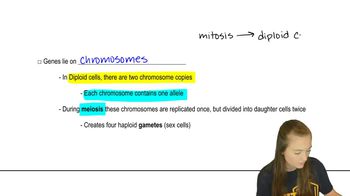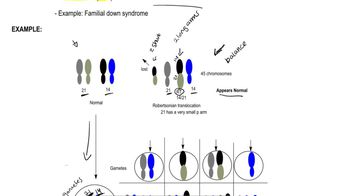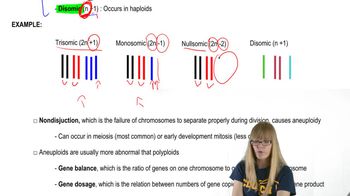Table of contents
- 1. Introduction to Genetics51m
- 2. Mendel's Laws of Inheritance3h 37m
- 3. Extensions to Mendelian Inheritance2h 41m
- 4. Genetic Mapping and Linkage2h 28m
- 5. Genetics of Bacteria and Viruses1h 21m
- 6. Chromosomal Variation1h 48m
- 7. DNA and Chromosome Structure56m
- 8. DNA Replication1h 10m
- 9. Mitosis and Meiosis1h 34m
- 10. Transcription1h 0m
- 11. Translation58m
- 12. Gene Regulation in Prokaryotes1h 19m
- 13. Gene Regulation in Eukaryotes44m
- 14. Genetic Control of Development44m
- 15. Genomes and Genomics1h 50m
- 16. Transposable Elements47m
- 17. Mutation, Repair, and Recombination1h 6m
- 18. Molecular Genetic Tools19m
- 19. Cancer Genetics29m
- 20. Quantitative Genetics1h 26m
- 21. Population Genetics50m
- 22. Evolutionary Genetics29m
6. Chromosomal Variation
Chromosomal Mutations: Aneuploidy
Problem 8b
Textbook Question
If the haploid number for a plant species is 4, how many chromosomes are found in a member of the species that has one of the following characteristics? Explain your reasoning in each case.
trisomy
 Verified step by step guidance
Verified step by step guidance1
Understand the concept of haploid and diploid numbers: The haploid number (n) is the number of chromosomes in a gamete (sperm or egg), which is 4 in this case. The diploid number (2n) is the total number of chromosomes in a somatic cell, which is 2 times the haploid number, so 2n = 8.
Define trisomy: Trisomy is a condition where an organism has one extra chromosome in addition to the normal diploid set. This means there is one chromosome present in triplicate instead of the usual pair.
Calculate the number of chromosomes in a trisomic individual: Start with the diploid number, which is 8 for this species, and add one extra chromosome to account for the trisomy.
Express the calculation: The total number of chromosomes in a trisomic individual is 8 (diploid number) + 1 (extra chromosome) = 9.
Summarize the reasoning: A member of this plant species with trisomy will have 9 chromosomes because it has one additional chromosome beyond the normal diploid set.
Recommended similar problem, with video answer:
 Verified Solution
Verified SolutionThis video solution was recommended by our tutors as helpful for the problem above
Video duration:
1mPlay a video:
Was this helpful?
Key Concepts
Here are the essential concepts you must grasp in order to answer the question correctly.
Haploid and Diploid Numbers
The haploid number (n) refers to the number of chromosomes in a gamete, which is half the total number of chromosomes in a diploid organism. In this case, if the haploid number for the plant species is 4, the diploid number (2n) would be 8, representing the total chromosomes in somatic cells.
Recommended video:
Guided course

Diploid Genetics
Trisomy
Trisomy is a genetic condition where an organism has three copies of a particular chromosome instead of the usual two. For a plant with a haploid number of 4, a trisomic individual would have one extra chromosome, resulting in a total of 9 chromosomes (4 + 1 = 9) in its somatic cells.
Recommended video:
Guided course

Robertsonian Translocations
Chromosome Structure and Function
Chromosomes are structures within cells that contain DNA and proteins, playing a crucial role in heredity and gene expression. Understanding chromosome structure is essential for grasping how variations like trisomy can affect an organism's development and traits, as the presence of an extra chromosome can lead to abnormal phenotypes.
Recommended video:
Guided course

Chromosome Structure
Related Videos
Related Practice




